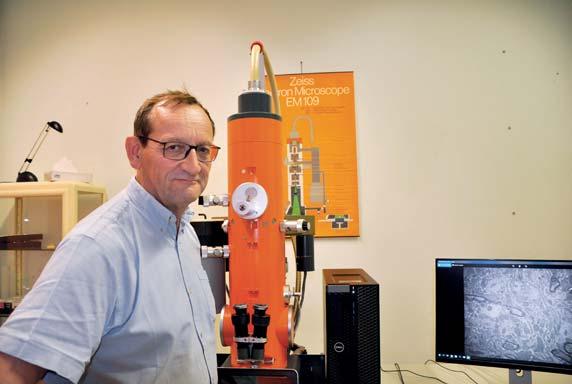
3 minute read
treatment of Alzheimer’s disease
by 5rXobdlLrFp
Laboratory of General Histology, Neuroanatomy and Neuropathology - ULB Passing from the preclinical phase to the translational phase for better treatment of Alzheimer’s disease
Established in 1999 on the Erasmus campus of ULB, the Laboratory of General Histology, Neuroanatomy and Neuropathology specialises in the structural and molecular analysis of brain lesions in Alzheimer’s disease. With its fifteen or so members, it conducts on average 5 projects every year and has authored 62 publications in international journals over the past 5 years.
Advertisement
The Laboratory has become a pioneer in being the first to identify the tau protein as a molecular component of a key lesion of the neurons at work in Alzheimer’s disease, and continues to study the dysfunctioning of this protein in Alzheimer’s disease and other neurodegenerative diseases in which this protein is involved. This discovery has led to an improved understanding of the mechanisms involved, increased diagnosis quality and opened up new therapeutic perspectives.
However, the mechanisms responsible for the formation of this type of lesion, notably abnormal accumulations of this tau protein, remain poorly understood, as do their effects on neuron biology. The Laboratory’s researchers are therefore working to clarify these mechanisms, while at the same time trying to interfere experimentally with the formation of these lesions. To this end, they reproduce them in cultured cells and animal models. The latter are also used to develop preclinical approaches for the purpose of testing various treatments in the concept proof stage - a crucial phase before transition to the translational stage. In addition, the Laboratory has a “brain bank”, i.e. a biobank of human tissue from autopsies on deceased patients: officially approved, this bank allows for valuable feedback in both directions between the study of pathological tissue and animal models.
The Laboratory also studies variations of certain genes that predispose to Alzheimer’s disease among the 95% of non-strictly genetic cases. Today, its researchers are working on understanding why these variants generate an increased risk of developing Alzheimer’s disease. Furthermore, ongoing projects aim to inter
© Laboratoire d'Histologie générale, de Neuroanatomie et de Neuropathologie
fere preclinically with the formation and propagation of tau lesions by targeting them through pharmacological and genetic approaches using new animal models. In fact, these lesions occur in a specific area of the brain and then propagate along neural pathways, resulting in a more or less systematic brain invasion pattern. The aim is therefore to prevent such propagation.
Thanks to progress in medical imaging (PET Scans in particular), the propagation of these lesions can now be visualised in the brain. This visualisation will make it possible to refine the diagnosis in order to better understand the relationship between the lesions and the clinical condition of the patient, and to objectify the effect of medicines on the development of the lesions. The lesions have often been present for a long time before the diagnosis is made, so it is equally vital to develop methods for earlier and more userfriendly detection of the tau protein and amyloid ß peptide (such as blood tests). However, fundamental research is just as crucial if we are to understand why the tau protein becomes abnormal and starts to produce lesions. In fact, the understanding of the mechanisms at work is indispensable for a successful transition to the translational level. The same applies for another major form of neuronal lesion in Alzheimer’s disease: the amyloid ß peptide.
Building on its numerous academic and industrial partnerships in Belgium and abroad, and on its integration with UNI (ULB Neuroscience Institute), the Laboratory resolutely aims at the transition from preclinical to translational, while also taking into consideration the multifactorial nature of Alzheimer’s disease. Hence the need to combine several approaches to improve the effectiveness of treatments: development of animal models to reproduce the lesions ever more faithfully and improve our understanding of the biological mechanisms, but also preclinical tests to disrupt lesion formation and other approaches such as those relating to inflammation, maintenance of adult neurogenesis, etc. A great deal of stimulating research beckons!
Laboratoire d'Histologie générale, de Neuroanatomie et de Neuropathologie ULB Campus Erasme, Bât. G2, niv. 7 Route de Lennik 808 - B-1070 Anderlecht Tel.: +32 (0)2 555 65 05 / 62 87 Email: jpbrion@ulb.ac.be http://cvchercheurs.ulb.ac.be/Site/unite/ULB598.php










